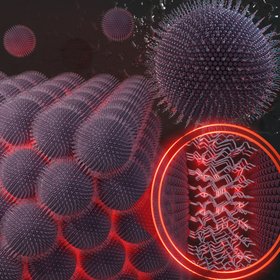Robust supercrystals
Materials scientists at TU Hamburg want to revolutionize high-tech applications
16.08.2022

Nanoparticles have a diameter of around one millionth of a millimeter and are so small that they are invisible to the human eye. Yet it is precisely their small size that holds many advantages. If individual nanoparticles were combined to form an ordered structure - a so-called supercrystal - new collective properties arise. This offers unique opportunities to scientists to design new materials with new exiting properties. A sensation, were it not for the fact that the individual nanoparticles within a supercrystal are usually held together only weakly and therefore the resulting macroscale materials are mechanically fragile. “Imagine you want to build a sandcastle. If the sand is dry, the individual grains of sand are hardly held together. But as soon as some water comes into play, small water bridges between individual grains form, holding the construction together.” explains Dr. Berta Domènech, research associate at Hamburg University of Technology and now a scientist at ams-OSRAM. Following a similar concept, researchers at the TU Hamburg, propose a strategy to form novel hybrid materials made of nanoparticles that are “as hard as diamond and as deformable as metal”.
Supercrystal with non-stick coating
How to create permanent bridges between nanoparticles finally came to the research team in the kitchen, more specifically while looking at a conventional cast iron pan. It has a unique non-stick coating that is formed when fats are baked onto the iron surface. The result is a very hard and durable surface. "We wondered what would happen if we used the same principle to make a supercrystal of iron oxide nanoparticles and stabilized it using fat-like organic molecules," says Alexander Plunkett, a materials researcher at TU Hamburg. The result is that a coating also forms within the supercrystal, holding the nanoparticles tightly together within the material without negatively affecting the nanostructure. "Our result is an important milestone for using nanotechnology more effectively in the future. In the next step, we want to find out more about the functional properties of our 3D-supercrystals. Indeed, due to the nanosized iron oxide used, the material is superparamagnetic (a property usually only found in nanoparticles) and can therefore be of significant interest for e-motors or micro-robotics," Plunkett added.
The project was funded by the German Research Foundation (DFG) as part of the TU's Collaborative Research Center 986 "Tailored Multiscale Material Systems". In addition to the TU Hamburg, the German Electron Synchrotron (DESY), the University of Hamburg, and the Vrije University in Brussels are also involved. Further details can be found in the article "Strengthening Engineered … nformation and Reactivity" in the scientific journal ACS Nano.
TUHH - Public Relations Office







